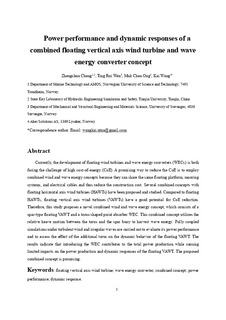| dc.contributor.author | Cheng, Zhengshun | |
| dc.contributor.author | Wen, Ting-Rui | |
| dc.contributor.author | Ong, Muk Chen | |
| dc.contributor.author | Wang, Kai | |
| dc.date.accessioned | 2019-12-19T08:53:06Z | |
| dc.date.available | 2019-12-19T08:53:06Z | |
| dc.date.created | 2019-05-04T12:41:22Z | |
| dc.date.issued | 2019 | |
| dc.identifier.citation | Energy. 2019, 171 190-204. | nb_NO |
| dc.identifier.issn | 0360-5442 | |
| dc.identifier.uri | http://hdl.handle.net/11250/2634081 | |
| dc.description.abstract | Currently, the development of floating wind turbines and wave energy converters (WECs) is both facing the challenge of high cost-of-energy (CoE). A promising way to reduce the CoE is to employ combined wind and wave energy concepts because they can share the same floating platform, mooring systems, and electrical cables and thus reduce the construction cost. Several combined concepts with floating horizontal axis wind turbines (HAWTs) have been proposed and studied. Compared to floating HAWTs, floating vertical axis wind turbines (VAWTs) have a good potential for CoE reduction. Therefore, this study proposes a novel combined wind and wave energy concept, which consists of a spar-type floating VAWT and a torus-shaped point absorber WEC. This combined concept utilizes the relative heave motion between the torus and the spar buoy to harvest wave energy. Fully coupled simulations under turbulent wind and irregular waves are carried out to evaluate its power performance and to assess the effect of the additional torus on the dynamic behavior of the floating VAWT. The results indicate that introducing the WEC contributes to the total power production while causing limited impacts on the power production and dynamic responses of the floating VAWT. The proposed combined concept is promising. | nb_NO |
| dc.language.iso | eng | nb_NO |
| dc.publisher | Elsevier | nb_NO |
| dc.rights | Attribution-NonCommercial-NoDerivatives 4.0 Internasjonal | * |
| dc.rights.uri | http://creativecommons.org/licenses/by-nc-nd/4.0/deed.no | * |
| dc.title | Power performance and dynamic responses of a combined floating vertical axis wind turbine and wave energy converter concept | nb_NO |
| dc.type | Journal article | nb_NO |
| dc.type | Peer reviewed | nb_NO |
| dc.description.version | acceptedVersion | nb_NO |
| dc.source.pagenumber | 190-204 | nb_NO |
| dc.source.volume | 171 | nb_NO |
| dc.source.journal | Energy | nb_NO |
| dc.identifier.doi | 10.1016/j.energy.2018.12.157 | |
| dc.identifier.cristin | 1695589 | |
| dc.description.localcode | © 2018. This is the authors’ accepted and refereed manuscript to the article. Locked until 24.12.2020 due to copyright restrictions. This manuscript version is made available under the CC-BY-NC-ND 4.0 license http://creativecommons.org/licenses/by-nc-nd/4.0/ | nb_NO |
| cristin.unitcode | 194,64,20,0 | |
| cristin.unitname | Institutt for marin teknikk | |
| cristin.ispublished | true | |
| cristin.fulltext | postprint | |
| cristin.qualitycode | 2 | |

